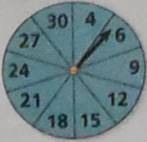
Concept explainers
(a)
To find: the theoretical probability that the spinner stops on a multiple of 3
(a)
Answer to Problem 17E
The theoretical probability that the spinner stops on a multiple of 3 is:
Explanation of Solution
Given:

Calculation:
The outcomes for a specified event are called favorable outcomes. When all outcomes are equally likely, the theoretical probability is described as the ratio of number of favorable outcomes to total number of outcomes.
There are 10 sections in a spinner, and out of these, 9 sections have numbers which are multiplier than 3. Therefore, for the given problem, the probability of each outcome is as follows:
Therefore, the theoretical probability that the spinner stops on a multiple of 3 is: 0.9
Conclusion:
Therefore, the theoretical probability that the spinner stops on a multiple of 3 is:
(b)
To find: the experimental probability of stopping on a multiple of 3
(b)
Answer to Problem 17E
the experimental probability of stopping on a multiple of 3 is:
Explanation of Solution
Calculation:
The experimental probability is the ratio of number of successes to number of trials. In the given situation, the spinner is rotated 30 times and the spinner has stopped on multiple of three 20 times.
The experimental probability of spinner stopping on a multiple of 3 is as follows:
The experimental probability of stopping on a multiple of 3 is
Conclusion:
The experimental probability of stopping on a multiple of 3 is
(c)
To explain: why the probability found in part (b) is different frompart (a).
(c)
Answer to Problem 17E
The differences arises because, the probability in second part is based on number of trials, not possible outcomes.
Explanation of Solution
Calculation:
Experimental probability is purely based on experimental results, thus, the differences arises because, the probability in second part is based on number of trials, not possible outcomes.
Conclusion:
The differences arises because, the probability in second part is based on number of trials, not possible outcomes.
Chapter 10 Solutions
BIG IDEAS MATH Algebra 2: Common Core Student Edition 2015
 Algebra and Trigonometry (6th Edition)AlgebraISBN:9780134463216Author:Robert F. BlitzerPublisher:PEARSON
Algebra and Trigonometry (6th Edition)AlgebraISBN:9780134463216Author:Robert F. BlitzerPublisher:PEARSON Contemporary Abstract AlgebraAlgebraISBN:9781305657960Author:Joseph GallianPublisher:Cengage Learning
Contemporary Abstract AlgebraAlgebraISBN:9781305657960Author:Joseph GallianPublisher:Cengage Learning Linear Algebra: A Modern IntroductionAlgebraISBN:9781285463247Author:David PoolePublisher:Cengage Learning
Linear Algebra: A Modern IntroductionAlgebraISBN:9781285463247Author:David PoolePublisher:Cengage Learning Algebra And Trigonometry (11th Edition)AlgebraISBN:9780135163078Author:Michael SullivanPublisher:PEARSON
Algebra And Trigonometry (11th Edition)AlgebraISBN:9780135163078Author:Michael SullivanPublisher:PEARSON Introduction to Linear Algebra, Fifth EditionAlgebraISBN:9780980232776Author:Gilbert StrangPublisher:Wellesley-Cambridge Press
Introduction to Linear Algebra, Fifth EditionAlgebraISBN:9780980232776Author:Gilbert StrangPublisher:Wellesley-Cambridge Press College Algebra (Collegiate Math)AlgebraISBN:9780077836344Author:Julie Miller, Donna GerkenPublisher:McGraw-Hill Education
College Algebra (Collegiate Math)AlgebraISBN:9780077836344Author:Julie Miller, Donna GerkenPublisher:McGraw-Hill Education





